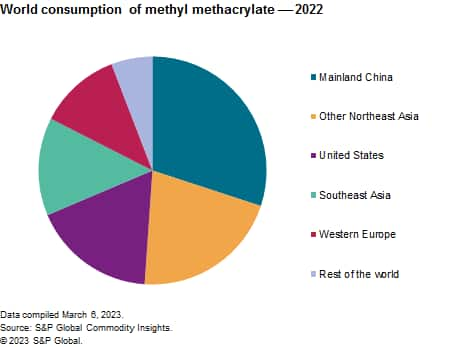Published April 2023
Methyl methacrylate (MMA) is widely used in large amounts for the production of polymethyl methacrylate (PMMA), which is used in applications such as cast and extruded sheet and resins (PMMA pellets) for injection molding and extrusion products. MMA is also used extensively in acrylic surface coatings (acrylic latexes and enamels) and adhesives. Other important applications for MMA include impact modification and acrylic processing aids; emulsion polymers principally for paper, textiles, leather and floor polishes; mineral-filled sheet; polyesters; and polymer concrete.
The following pie chart shows world consumption of methyl methacrylate in 2022:

Mainland China was the largest consumer of MMA at 30% of global consumption in 2022. In the last five years, the MMA market has been heavily defined and influenced by: the global automobile and construction industries, older versus newer MMA technologies, raw material shortages, new MMA trade flows (especially from Saudi Arabia exports), new MMA capacity in mainland China, the COVID-19 pandemic, increases in global PMMA sheet production and consumption (for example sneeze guards), the conflict in Ukraine (including geopolitical instability) and high inflation.
PMMA accounted for close to two-thirds of global consumption of MMA. Acrylic surface coatings and other uses accounted for the remainder.
For more detailed information, see the table of contents, shown below.
S&P Global’s Chemical Economics Handbook – Methyl Methacrylate is the comprehensive and trusted guide for anyone seeking information on this industry. This latest report details global and regional information, including

Key benefits
S&P Global’s Chemical Economics Handbook – Methyl Methacrylate has been compiled using primary interviews with key suppliers and organizations, and leading representatives from the industry in combination with S&P Global’s unparalleled access to upstream and downstream market intelligence and expert insights into industry dynamics, trade, and economics.
This report can help you
- Identify trends and driving forces influencing chemical markets
- Forecast and plan for future demand
- Understand the impact of competing materials
- Identify and evaluate potential customers and competitors
- Evaluate producers
- Track changing prices and trade movements
- Analyze the impact of feedstocks, regulations, and other factors on chemical profitability


















